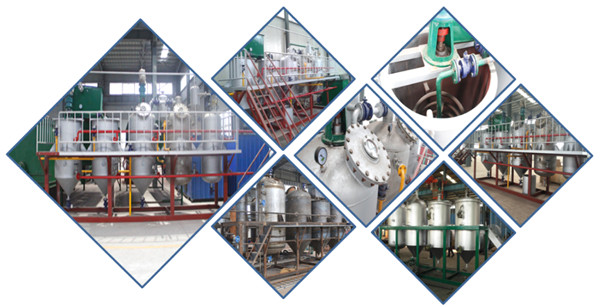Why cotton seeds oil need refining?
It is said that refining process can reduce toxicity. Cottonseed oil is one of main cooking oil. But crude cottonseed oil contains gossypol (approximate 1%), colloid and waxiness (content vary with shell content), and the quality is poor. It’s not better to eat it directly. The refining process technology is also complex.
What is the features of fefined cottonseed oil?
Refined cottonseed oil usually is pale yellow or dark red. Its fatty acid generally includes 21.6-24.8% palmitic acid, 1.9-2.4% stearic acid, 0.1% arachic acid, 18.0-30.7% oleic acid, and 44.9-55.0% linoleic acid. Refined clear cottonseed oil without gossypol and other toxic substance can be used as cooking food. Due to clear cottonseed oil contains a large quantity of linoleic acid, it can prevent the content of cholesterol rising, maintain human body health. Human body consumption to cottonseed oil is up to 98%.
Brief Introduction of Cotton Seeds Oil Refinery Plants:
Oil Refining is a process of removing the impurities such as phospholipids, FFA, pigment, off-flavor in cruel oil before edible application. Oil refining machine is used for producing the first or second grade edible oil. We are able to supply the professional oil refining plant and related oil refining equipments. With high degree of automation,the oil refining machinery can refine 20 kinds of oil, such as soybean, rape seeds, peanut, etc. in a small production line or in large oil plant.

1-2-3-5tpd cooking oil refinery plant

This is the raw materials our cooking oil refinery plant can process
The Process of Cotton Seeds Oil Refinery Plants
Degumming Process:
This progress adopts hydration by adding into hot water to remove the agglomerated and deposited hydrosol and phosphatide because of their water affinity. The separated gum (after being dried) can be made into lecithin or added into cakes or meals in the extraction workshop. Hydration degumming process can improve oil edibility, storage and do well to downstream neutralization section.
Neutralizing Process:
Oil containing fatty acid is mixed mechanically with a slight excess of alkali to react with fatty acids present to form soaps. The mixture is centrifuged to separate oil from soap stock. After washing with water, the water is separated from the oil in a second centrifuge.
Bleaching Process:
Degummed and neutralized oil are pumped into this system and mixed with by the use of bleaching earth, a special soap, gum, and pigment attracting adsorbent. The mixture enters the Pre-filtration Dryer where the moisture in the oil and adsorbent is evaporated. Then the oil is pumped through an automatic closed filter to remove clay.
Deodorization Process:
The oil contains the disagreeable flavor and odors that are naturally present or created during processing. All odoriferous matter is distilled off by injecting high pressure steam through vacuum system. Then the product achieves the national standard.